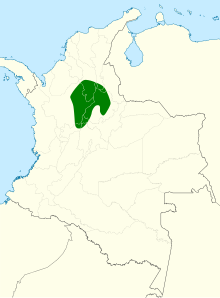Beautiful woodpecker
| Beautiful woodpecker | |
|---|---|

| |
| Scientific classification | |
| Domain: | Eukaryota |
| Kingdom: | Animalia |
| Phylum: | Chordata |
| Class: | Aves |
| Order: | Piciformes |
| Family: | Picidae |
| Genus: | Melanerpes |
| Species: | M. pulcher
|
| Binomial name | |
| Melanerpes pulcher Sclater, PL, 1870
| |

| |
| Synonyms | |
|
Tripsurus pulcher | |
The beautiful woodpecker (Melanerpes pulcher) is a species of bird in subfamily Picinae of the woodpecker family Picidae. It is endemic to Colombia.[2]
Taxonomy and systematics
[edit]From about the middle of the 20th century until early in the 21st century most taxonomic systems treated the beautiful woodpecker and the golden-naped woodpecker (M. chrysauchen) as conspecific. The combined species and several others were for a time placed in genus Tripsurus.[3] The beautiful woodpecker is monotypic.[2]

Description
[edit]The beautiful woodpecker is about 17 to 18 cm (6.7 to 7.1 in) long. The sexes are alike except for their head pattern. Adult males have a whitish forehead, a scarlet crown, and a golden yellow lower nape and hindneck. Adult females have the same whitish forehead and yellow hindneck but a black forecrown and a scarlet hindcrown and nape. Both sexes have black around the eye that extends down the side of the neck. Their lores, cheeks, chin, throat, and breast are white to cream or pale yellow. Their mantle and upper wings are mainly black, with some white barring of the flight feathers, and the back and rump are white, sometimes blotched with black. Their tail is brownish black, the lower breast, belly, and flanks are barred black and white, and there is a red patch on mid-belly. Their iris is very dark brown, the beak is blackish with a paler base, and the legs are gray. Juveniles are duller than adults, their black areas are browner, the underparts' barring is less contrasting, and the belly patch is smaller and more orange.[4]
Distribution and habitat
[edit]The beautiful woodpecker is endemic to the valley of the Magdalena River in north central Colombia. It primarily inhabits mature open forests, both dry and humid. It sometimes occurs in plantations, and occasionally in fragmented and secondary forest. In elevation it ranges between 400 and 1,500 m (1,300 and 4,900 ft).[4]
Behavior
[edit]Movement
[edit]The beautiful woodpecker is a year-round resident throughout its range.[4]
Feeding
[edit]The beautiful woodpecker mostly forages high in the forest, in the canopy and just below it. It feeds on insects including adult and larval wood-boring beetles and winged termites; it sometimes hawks flying insects above the tops of the trees. In addition to insects it feed on much fruit including figs, bananas, and fruits of the Cecropia tree.[4]
Breeding
[edit]The beautiful woodpecker's breeding season is thought to be from February or March to June or July, but nothing else is known about its breeding biology.[4]
Vocal and non-vocal sounds
[edit]The beautiful woodpecker's most common call is "loud, rather squeaky, sometimes more guttural, [and] usually of 3 notes". It also makes "rattling trills" and a "churring call". Both sexes are believed to drum.[4]
Status
[edit]The IUCN has assessed the beautiful woodpecker as being of Least Concern. Though it has a limited range and its population size is not known, the latter is believed to be stable. No immediate threats have been identified.[1] The species "appears to be rather scarce and local throughout."[4]
References
[edit]- ^ a b BirdLife International (2016). "Beautiful Woodpecker Melanerpes pulcher". IUCN Red List of Threatened Species. 2016: e.T22733737A95063710. doi:10.2305/IUCN.UK.2016-3.RLTS.T22733737A95063710.en. Retrieved 17 January 2023.
- ^ a b Gill, F.; Donsker, D.; Rasmussen, P., eds. (August 2022). "Woodpeckers". IOC World Bird List. v 12.2. Retrieved January 9, 2023.
- ^ Remsen, J. V., Jr., J. I. Areta, E. Bonaccorso, S. Claramunt, A. Jaramillo, D. F. Lane, J. F. Pacheco, M. B. Robbins, F. G. Stiles, and K. J. Zimmer. Version 24 July 2022. A classification of the bird species of South America. American Ornithological Society. https://www.museum.lsu.edu/~Remsen/SACCBaseline.htm retrieved July 24, 2022
- ^ a b c d e f g del Hoyo, J., N. Collar, and D. A. Christie (2020). Beautiful Woodpecker (Melanerpes pulcher), version 1.0. In Birds of the World (J. del Hoyo, A. Elliott, J. Sargatal, D. A. Christie, and E. de Juana, Editors). Cornell Lab of Ornithology, Ithaca, NY, USA. https://doi.org/10.2173/bow.beawoo2.01 retrieved January 17, 2023
Further reading
[edit]- Gorman, Gerard (2014). Woodpeckers of the World: A Photographic Guide. Firefly Books. pp. 122–123. ISBN 978-1770853096.


